For millennia, travelling by land across the British Isles was a dangerous and slow business. Most people when they could travelled by boat on rivers and along the sea-coast and later by canals.
Travelling by land was a slow and arduous thing to do at the best of times. After the Romans, the roads largely fell into disrepair and stayed that way until the turnpikes moved us towards modernity. To make it worse, much of the land was forested with wolves and bears lurking in the darkness. Isolated and impoverished hill-billy villagers from time to time did travellers in and then there were the highway men.
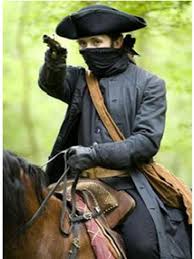
Highwaymen were really the closest we got to the wild-west cowboys but they were far to close to comfort for those who lived in those times. They rode horses, often worked in pairs or gangs and held up travellers and stagecoaches imploring their victims to
Stand and deliver, your money or your life.
Depending on the morals of the highway men, handing over money, valuables or even women might be enough to save ones life but it was no guarantee. If one refused to hand over their belongings or made a wrong move then they would be shot. This was particularly the case once a highway man had been identified as robbery by force was a Capital Offence and as such the highwayman had little reason to leave any witnesses.
Strangely, despite their despicable actions, highwaymen even at the time were thought to be socially superior than common thieves and brigands. They were romanticised by many in a way similar to Robin Hood and were euphemistically referred to as Knights of the road or Gentlemen of the road.
A fellow of a good Name, but poor Condition, and worse Quality, was Convicted for laying an Embargo on a man whom he met on the Road, by bidding him Stand and Deliver, but to little purpose; for the Traveller had no more Money than a Capuchin, but told him, all the treasure he had was a pound of Tobacco, which he civilly surrendered.
—The Proceedings of the Old Bailey, 25 April 1677
Highwaymen would often work on the roads that radiated from London and other major cities. They would wait in ambush in the woods and heath-lands waiting for a tempting and poorly defended target. Even modern day places of leisure such as Hyde Park was preyed on by Highwaymen in the 17th century and the short road between some of the Royal Palaces was the first road in the country to be lit by lamps during periods of nightfall.
Though many were armed with daggers and swords, most also sported muskets rather like my one below. They could only fire one shot at a time and weren’t always accurate and so many highwaymen would have 2 muskets loaded and ready for action.
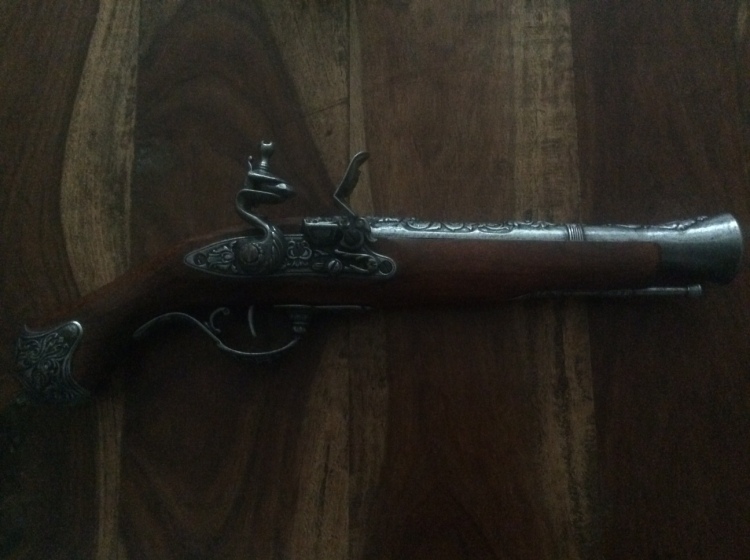
One of the most infamous highwaymen was Dick Turpin. Dick Turpin was a deer thief, poacher, burglar, horse-thief, highwayman and murderer. On his horse, Black Bess, he terrorised travellers on the 200 mile long route between London and York.
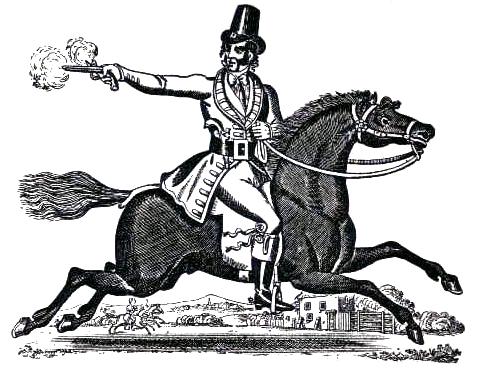
Born in 1705, he moved from York to the county of Essex as a young man where he became involved in the deer thievery trade and began working with the Essex Gang. So many deers were taken that this minor domestic crime grew in importance and much effort was placed on breaking up the trade in the area leading to many gang members being caught or fleeing.
As such the few remaining members started raiding and robbing wealthy households of a certain social standing and in 1734/35 they carried out countless such raids.
On Saturday night last, about seven o’clock, five rogues entered the house of the Widow Shelley at Loughton in Essex, having pistols &c. and threatened to murder the old lady, if she would not tell them where her money lay, which she obstinately refusing for some time, they threatened to lay her across the fire, if she did not instantly tell them, which she would not do. But her son being in the room, and threatened to be murdered, cried out, he would tell them, if they would not murder his mother, and did, whereupon they went upstairs, and took near £100, a silver tankard, and other plate, and all manner of household goods. They afterwards went into the cellar and drank several bottles of ale and wine, and broiled some meat, ate the relicts of a fillet of veal &c. While they were doing this, two of their gang went to Mr Turkles, a farmer’s, who rents one end of the widow’s house, and robbed him of above £20 and then they all went off, taking two of the farmer’s horses, to carry off their luggage, the horses were found on Sunday the following morning in Old Street, and stayed about three hours in the house.
—Report from Read’s Weekly Journal (8 February 1735)
Soon things began to spiral out of control, the gang became more violent and their notoriety spread throughout the land. When one of their number, a young lad of about 15 years of age, was caught, he quickly confessed and gave the authorities all they needed to know about the gang and Dick Turpin in particular who was described in the London Gazette as “Richard Turpin, a butcher by trade, is a tall fresh coloured man, very much marked with the small pox, about 26 years of age, about five feet nine inches high, lived some time ago in Whitechapel and did lately lodge somewhere about Millbank, Westminster, wears a blue grey coat and a natural wig”.
The robberies continued as the gang hid in the impenetrable Epping Forest but four of their number were captured when drinking in London and they were hanged at the famous Tyburn gallows with their bodies being hung out to rot in gibbets along Edgware Road. Dick Turpin evaded capture but he was now very much a wanted man.
Another string of robberies saw the remaining gang members injured, arrested and executed leaving Turpin to find a new profession, that of a highwayman. With a bounty of £100 on his head, Dick Turpin started his highway robberies in April 1735 in Epping Forest and through the summer attacked travellers on Hounslow Heath, a coach load of five people on Barnes Common before moving off to attack those in the county of Hertfordshire and then 70 miles south west towards Winchester.
It is thought that Turpin spent 1736 in the Netherlands continuing his highwayman career before returning to the Cambridge area in 1737 where he and two accomplishes held up a number of coaches and made many robberies until one got out of control leading to one of Turpin’s partners in crime being fatally shot. Dick Turpin fled to his hideout in Epping Forest where he was discovered by Thomas Morris,a servant of one of the Forest keepers. Morris attempted to capture the highway but was shot.
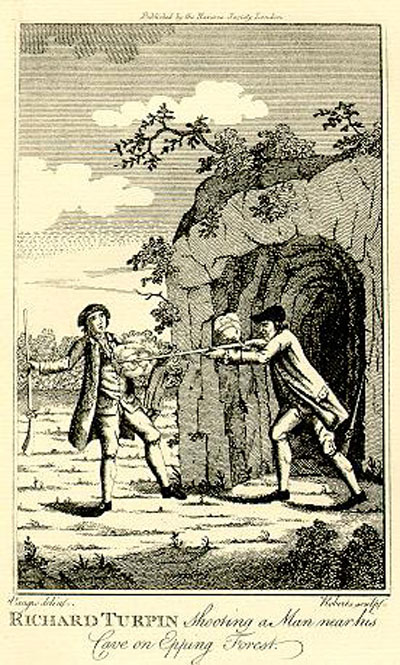
The London area was now too hot for Turpin who fled north through Lincolnshire and towards Yorkshire where though he tried to fit in under the assumed name of John Palmer with an identity of horse-trader and gentleman hunter. His natural violent tendencies meant he kept coming to attention. He once killed a cockerel in the street and when his owner complained in public, Turpin threatened to shoot him as well.
It was thought that John Palmer may have gained his wealth from criminal endeavours but when he was arrested for this minor crime and taken to jail, no-one suspected that they had the most wanted man in England. This was all to change by an incredible and for Turpin and terribly unfortunate co-incidence.
From his cell, Turpin wrote a letter to his brother-in-law, Pompr Rivernall in Hempstead. His brother-in-law though didn’t think he knew anyone from York and didn’t want to risk paying the postage for the 18th century equivalent of spam and so the letter was taken to the local post office. Here James Smith a former school master who worked at the post office recognised the handwriting as being one of his former pupils, Dick Turpin. Smith travelled up to York and identified John Palmer as Dick Turpin and collected the £200 reward (about £28,000 or $50,000 in today’s money).
At the time, theft and property crime was very serious. In fact many still believe that property crime is punished more seriously in the U.K. than murder. There were over 200 theft and property offences punishable by death. As Turpin had robbed some of the most important people in the kingdom and committed murder too, his conviction was almost an open and closed case.
It was not helpful that Turpin continually claimed his supposed witnesses and character references never turned and his request for more time and for the trial to be moved to Essex was turned down. He was found guilty by the jury.
Before sentencing him, the judge asked Turpin if he could offer any reason why he should not be sentenced to death; Turpin said: “It is very hard upon me, my Lord, because I was not prepar’d for my Defence.” The judge replied: “Why was you not? You knew the Time of the Assizes as well as any Person here.” Despite Turpin’s pleas that he had been told the trial would be held in Essex, the judge replied: “Whoever told you so were highly to blame; and as your country have found you guilty of a crime worthy of death, it is my office to pronounce sentence against you”, sentencing him to death.
Before his execution, Turpin was visited my a long line of people, so many came over the coming days that the jailer made £100 selling them drinks. The day before his death, Turpin bought new shoes and a coat as well as hiring 3 mourners for 3 pounds and 10 shillings.
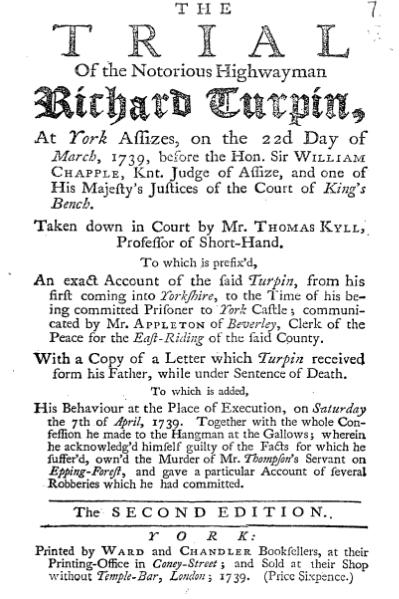
On 7th April 1739, Dick Turpin and another unrelated criminal were taken by cart through York. Turpin behaved impeccably and bowed to the assembled crowd. An account in The Gentleman’s Magazine for 7 April 1739 notes Turpin’s brashness: “Turpin behaved in an undaunted manner; as he mounted the ladder, feeling his right leg tremble, he spoke a few words to the topsman, then threw himself off, and expir’d in five minutes.”
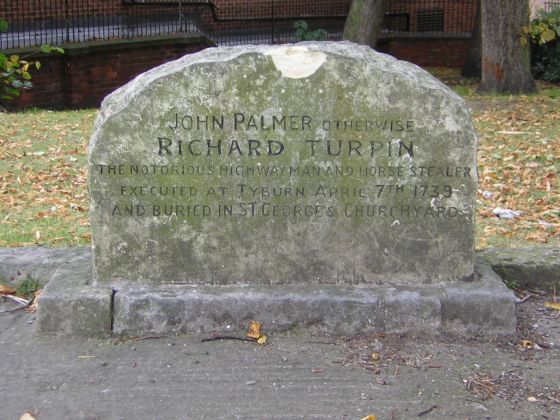
Turpin was left hanging all afternoon when he was cut down and buried the next morning at St. George’s church but within a few days, his body had been taken by grave robbers, mostly likely to sell his body for medical research. The perpetrators were quickly found and he was reburied inside a quick lime tomb.
Since then, Dick Turpin has been immortalised by Victorian novelists, TV series and movies and in 1981 Adam and the Ants achieved global fame with the first of their historically themed records “Stand and Deliver” which was the number 1 hit in the UK for 5 weeks. Dick Turpin was a dastardly criminal who much like figures such as Robin Hood before him and Billy the Kid afterwards has long since become a folk-hero.
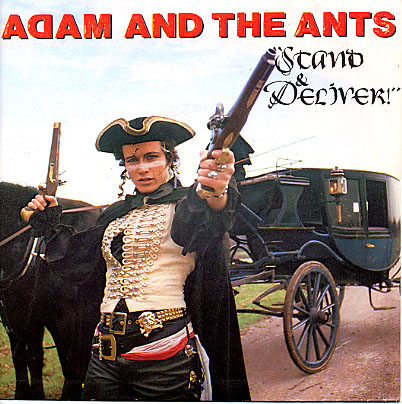
As entertaining and informative as ever!
LikeLike
Great post. The name Turpin sounds familiar. I think Terry Pratchett may have referenced the highway man in Lords and Ladies. Love the Adam Ant nod; I’d forgotten all about that album.
LikeLike